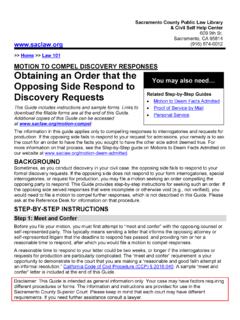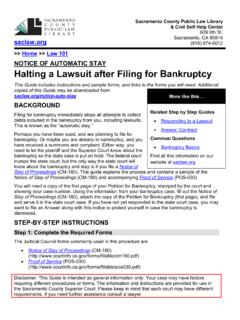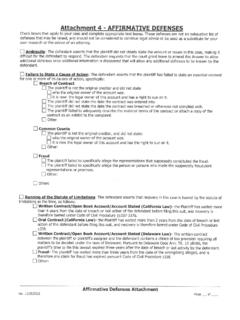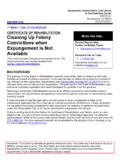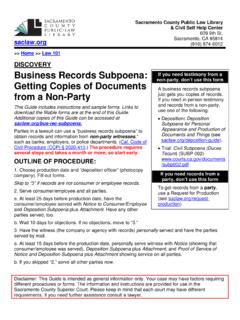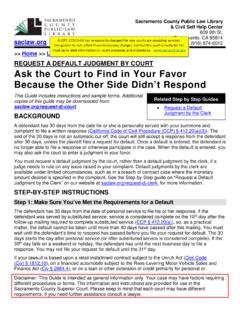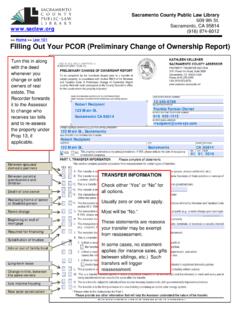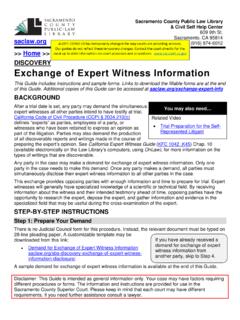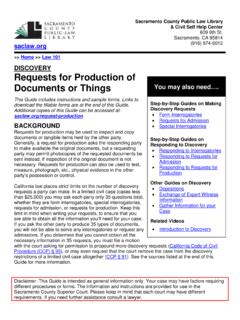Transcription of Bank Levy: Collect Your Judgment from the Debtor’s Bank ...
1 Sacramento County Public Law Library & Civil Self Help Center 609 9th St. ALERT: COVID-19 has temporarily changed the way courts are providing services. Sacramento, CA 95814. Our guides to no reflect these temporary changes. Contact the court directly for the most up to date information on court processes and procedures. (916) 874-6012. >> Home >> Law 101. bank levy . Collect Your Judgment from the Debtor's bank Account Related Step-by-Step Guides on Collecting Judgments This Guide includes instructions and sample forms.
2 Links to download the fillable forms are at the end of this Guide. Abstract of Judgment Additional copies of this Guide can be accessed at Debtor's Exam Enforcement of Judgments Memorandum of Costs BACKGROUND Wage Garnishment After you've won your lawsuit and received a Judgment against the other party, your next step is to attempt to Collect Related Videos what you're owed. The court does not Collect your Judgment Enforcement of Judgments for you as the Judgment creditor, this is your job. Related Guides on Opposing a If the Judgment debtor has a bank account, you may be able bank levy to take money from the account, using a process called a bank levy .
3 An account held jointly by the Judgment debtor Claim of Exemption- bank and his or her spouse or another person, or held solely by the levy Judgment debtor's spouse, may also be levied. Exemptions from Enforcement of Judgment STEP-BY-STEP INSTRUCTIONS. Step 1: Locate the Judgment Debtor's bank Account(s). If the Judgment debtor is someone from whom you've received a check, you may already have this information. Otherwise, you may wish to conduct a Debtor's Examination. This is a formal court proceeding in which the Judgment creditor may question the debtor about the location and value of the Judgment debtor's assets, including information about his or her bank account(s).
4 For more information, see the Step-by-Step guide on Debtor's Examinations on our website at Step 2: Obtain a Writ of Execution To levy the debtor's bank account, you must ask the court to issue a writ of execution. This is a court order instructing the Sheriff to enforce your Judgment in the county where the assets are located. Step 2a: Complete the Writ of Execution (EJ-130) form To levy a debtor's bank account, you must ask the court to issue a writ of execution. This is a court order instructing the Sheriff to enforce your Judgment in the county where the assets are located.
5 This Disclaimer: This Guide is intended as general information only. Your case may have factors requiring different procedures or forms. The information and instructions are provided for use in the Sacramento County Superior Court. Please keep in mind that each court may have different requirements. If you need further assistance consult a lawyer. bank levy >>Home >>Law 101. may be a different county from the one that issued the Judgment , or where the party lives. The Judicial Council form used to obtain a writ of execution is: Writ of Execution (EJ-130).
6 Instructions for completing this form are available at the end of this Guide. Step 2b: Adding Costs and Interest If you wish to add additional costs incurred after entry of Judgment , such as the costs associated with enforcing the Judgment ( , the cost of issuing the writ of execution, levying officers' fees, fees for the debtor's examination, etc.) or accrued interest on your Judgment amount, you must file a Memorandum of Costs after Judgment (MC-012) with your Writ of Execution (EJ-130). You must serve your Memorandum of Costs after Judgment (MC-012) on the Judgment debtor prior to filing.
7 The Judgment debtor has 10 days after service of the Memorandum of Costs after Judgment (MC- 012) to oppose it by filing a motion to tax costs (Code of Civil Procedure (CCP) (c)). For more information on the procedure and forms, see the Step-by-Step guide on Adding Costs and Interest to a Judgment on our website at Step 2c: Obtain a File-Endorsed Copy of Your Judgment You will need to provide the court with a file-endorsed (stamped) copy of your Judgment . If you do not have one, you may download a copy from the court's website: Step 2d: File Your Documents File the following items with the court: Writ of Execution (EJ-130) (original + 2 photocopies).
8 Memorandum of Costs after Judgment (MC-012), if desired (original + 2 photocopies). File-endorsed (stamped) copy of the Judgment Filing fee (currently $40, current fees at ). File your documents in the drop box at the courthouse at 720 Ninth Street. Fill out and attach the Civil Document Drop-Off Sheet ( ), and date stamp the back of your original documents. Following the instructions posted at the drop box, place your documents in the drop box, along with a check or Credit Card Authorization Form for the filing fee.
9 Provide the court with a self-addressed stamped envelope with sufficient postage to facilitate the return of your documents to you. If you filed a Memorandum of Costs after Judgment (MC-012) along with your Writ of Execution (EJ- 130), and your costs are more than $100, the clerk will wait 10 days (15 days, if served by mail) to issue Writ of Execution, to allow the Judgment debtor to oppose your costs by filing a Motion to Tax Costs (CCP ). If your costs are less than $100, or if you did not file a Memorandum of Costs, your Writ can be issued immediately.
10 The clerk will return the issued documents to you by mail. Your Writ of Execution (EJ-130) will be valid for 180 days after it is issued. Step 3: Obtain Supporting Documents, if Needed In some special situations, the levying officer will ask for additional documentation in order to levy a bank account. 2. bank levy >>Home >>Law 101. Spousal Affidavit California law (CCP (b)) allows a Judgment creditor to Collect money from the bank account in the name of the debtor's spouse even when the debtor's name is not on the account.
